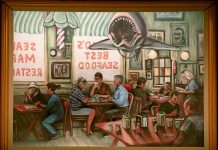This week marks the 20th anniversary of the death of one of the most beloved authors of children’s literature, Roald Dahl.
Dahl, who was best known for writing “The Little Prince,” “Charlie and the Chocolate Factory” and “James and the Giant Peach,” effortlessly captured the imagination of his young readers while breathing life into some of the most lovable, colorful, strange and eccentric characters in children’s books. In addition, he wrote adult short stories, screenplays and poetry.
When Dahl’s biography “Storyteller: The Authorized Biography of Roald Dahl” by Donald Sturrock recently hit the shelves, I was most eager to read it.
The 500-plus-page book proved to be a bittersweet read for me.
Aside from his two memoirs written for children, (“Boy” and “Going Solo”) there had been no detailed account of Dahl’s life. I was curious and anxious to take an in-depth peek at one of my favorite authors and heroes.
As I began the biography, the child in me still wanted to believe Dahl was nothing more than an expert weaver of tales, a magical man who understood how children felt, how they wanted to be loved, and how adults so often mistreated or misunderstood them. A cross between Willy Wonka and Father Goose.
“Storyteller” confirms what Dahl himself wrote in “Danny, Champion of the World”: “Grown ups are complicated creatures full of quirks and secrets. Some have quirkier quirks and deeper secrets than others but all of them, including all our own parents, have two or three private habits hidden in their sleeves that would probably make you gasp if you knew about them.”
While extremely well written and seemingly very accurate, I had mixed feelings as I read “Storyteller” because I was forced to see Dahl as a complex human being.
Author Sturrock knew Dahl personally. In 1986 he made a documentary about Dahl’s life for BBC. Before Dahl died, he appointed his daughter Ophelia to be his biographer, or choose one. She began his biography, but after years of being busy with her own projects she finally decided to pass the torch and chose Sturrock.
Through interviews with family members and friends as well as Dahl’s own letters, and time spent with Dahl himself, Sturrock reveals a man full of contradictions. A man who likes solitude as much as company. An opinionated man with a short fuse. A generous man who gave so that “only the recipient ever knows of his generous acts.”
Sturrock begins by carefully laying out his lineage back to his great, great, grandparents so by the time Roald is born somewhere around page 40 the reader has a firm grasp of the family tree.
Dahl endured an alarming number of tragedies. His daughter Olivia died of the measles when she was 7 and his son Theo as a baby suffered a massive head injury in an accident. His wife, actress Patricia Neal suffered a stroke, and had to learn how to speak again.
Dahl played a pivotal role in each of these tragic events. Yet again, we find contradiction. Dahl had a 10-year affair with a family friend, Liccy, whom he married after divorcing Neal.
For me, the most interesting parts of “Storyteller” were learning about the stories behind the stories. How the books that I devoured as a child and more recently with my own children came to be.
Sturrock did a stellar job in chronicling Dahl’s life and as objectively as possible showing his readers the real Roald Dahl.
However, I can’t help but wonder, with all the knowledge I gained about Dahl, if some of the magic for me was lost along the way.




